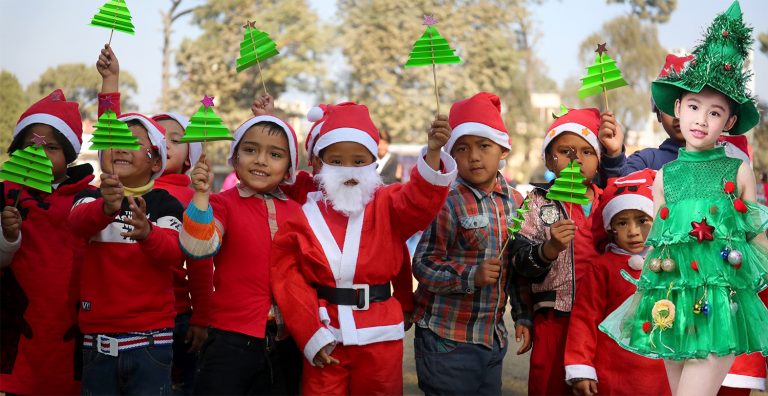
Christmas Day is celebrated by Christians around the world to commemorate the birth of Jesus Christ. It falls on December 25, when public holiday around the world. This is not the month and date of Jesus’ birth, but the Western Christian Church states that he was born on December 25 and this date was adopted by everyone. The date may have been chosen nine months after Jesus was conceived.
This festival was not celebrated in Nepal during historical days. Today, however, Christmas is not limited to any particular religion or geography. It is celebrated with great importance even by the Nepalese. This is confirmed by the Santa Claus clothes and hats, Christmas tree and decorative items seen in the shops in Nepal as Christmas approaches.
Therefore, every year on December 25, the world rejoices in the joy of Christmas. You may have various curiosity in your minds including; how did such a grand celebration begin? What is the significance of Santa Claus? Why is a Christmas tree indispensable? So, here I have tried to explain the history of Christmas day and some interesting facts about it.
What is the History of Christmas?
No one knows for sure who Jesus Christ is. This is an unsolved mystery. If so, why is 25th December celebrated as his birthday? The question is justified.
According to a popular legend, on March 25, Yeshu’s mother i.e., Mary found out that she was about to give birth to a special baby. Therefore, it is estimated that he may have been born on December 25, exactly after 9 months. Some Christians also believe that the world was created on this day.
As the days get longer and the nights get shorter since December 25, this day is also considered as the victory of light over darkness. History shows that the Roman emperor Constantine first celebrated Christmas on December 25, 336 AD.
Who is Santa Claus?
St. Nicholas, a Christian monk born in Turkey in 280, was famous for his generosity. He used to go to the villages to help the poor, the sick and the children by donating all his property. It is also said that he have freed women from slavery.
Gradually, his example of generosity spread to Europe and America. In Dutch, he was called Sinter Class. The name is derived from ‘Santa Claus’. Even today, Santa Claus is known as a generous, and pure-hearted character. Kids love Santa Claus. Dressed in a red suit and hat, with thick hair and a beard, Santa Claus has a tradition of carrying Christmas gifts in his lap and distributing them from house to house.
What is the significance of the Christmas tree?
A Christmas tree is a must at Christmas. On this day, it is customary to decorate the living room of the house with natural or artificial trees. The practice of tree-planting is believed to have originated in ancient Roman civilization. This evergreen tree signifies spring. Planting such a tree in mid-winter reflects the optimistic thought that spring will return.
Why Socks are hung during Christmas Day?
It is customary to hang socks near the chimney of the house on Christmas day. Surprising to hear, this trend has started by chance. It is said that a poor man did not have enough money to pay for a dowry for his three daughters. So, one night, St. Nicholas left a bag full of gold coins in the dried socks of a poor man near the chimney. From that day onwards, it was customary to dry socks near the chimney.
How is Christmas celebrated?
During Christmas, the courtyard is decorated and Lord Jesus is worshiped in the churches by exchanging good wishes. There is a tradition of exchanging happiness with each other by giving Santa Claus gifts. There is a belief that Santa Claus will bring happiness to everyone. The children write a pile of letters to Santa Claus by mentioning their wishes.
Currently, there are 12,500 churches and more than 3 million Christians in Nepal. Till 2074 BS, public holiday was given to all Nepalese. But, from 2075 BS, only Christians are given holiday. Christmas is in full swing in the touristy areas like Thamel, Boudha, Pokhara, Sauraha and other places.
Festivals like Christmas Day are of great importance in our multi-ethnic, multi-lingual, multi-religious and multi-cultural country. Protecting, promoting and promoting them is the common responsibility of all citizens. Finally, I wish that Christmas Day would inspire all Nepalese to fulfill the national aspiration of “Prosperous Nepal, Happy Nepali” and build a beautiful, and peaceful Nepal by enhancing the spirit of mutual harmony, love, unity and brotherhood among all Nepalese.
-Article written by: Kusum Kharel for Land Nepal